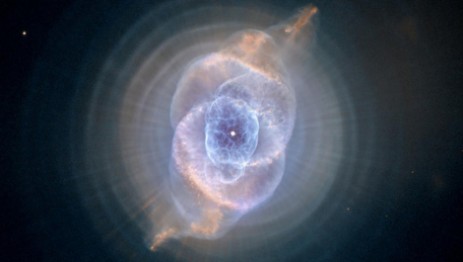Una farfalla ... dalla morte di una stella
Questo oggetto celeste si presenta come una farfalla delicata. Ma è tutt'altro che tranquillo.
Quelle che assomigliano ad ali di farfalla sono in realtà delicate turbolenti nubi di gas riscaldato a circa 20.000° C. Il gas sta viaggiando attraverso lo spazio a circa 965.000 Km all'ora - abbastanza veloce per viaggiare dalla Terra alla Luna in 24 minuti!
Al centro di tutto questa furia, una stella morente, (nana bianca) che una volta era circa cinque volte la massa del Sole. La stella ha espulso il suo involucro di gas e ora sta scatenando un flusso di radiazioni ultraviolette che sta facendo brillare il materiale fuso.
This celestial object looks like a delicate butterfly. But it is far from serene.
What resemble dainty butterfly wings are actually roiling cauldrons of gas heated to more than 36,000 degrees Fahrenheit. The gas is tearing across space at more than 600,000 miles an hour - fast enough to travel from Earth to the moon in 24 minutes!
A dying star, (white dwarf) that was once about five times the mass of the Sun is at the center of this fury. It has ejected its envelope of gases and is now unleashing a stream of ultraviolet radiation that is making the cast-off material glow.
NGC 6302: Nebulosa farfalla
La Nebulosa Farfalla è una nebulosa planetaria bipolare visibile nella costellazione dello Scorpione; è una delle nebulose di questa classe più interessanti e complesse conosciute. Lo spettro di NGC 6302 mostra che la sua stella centrale è uno degli oggetti più caldi conosciuti nella nostra Galassia, con una temperatura superficiale superiore ai 200.000 kelvin, implicando il fatto che la stella progenitrice doveva essere molto grande.
Questa stella, una nana bianca, è stata recentemente scoperta (Szyszka et al. 2009), usando Wide Field Camera 3 di Hubble Space Telescope. La massa attuale della stella è di circa 0,64 masse solari. dato che è circondata da un disco equatoriale particolarmente denso di gas e polveri; questo disco avrebbe causato i getti della stella che oggi formano una struttura bipolare, dalla forma simile ad una clessidra. La struttura mostra diverse caratteristiche interessanti come muri di ionizzazione e addensamenti. Image Credit: NASA, ESA, and the Hubble SM4 ERO Team Per approfondimenti
NGC 6302, also called Butterfly Nebula, is a bipolar planetary nebula in the constellation Scorpius. The structure in the nebula is among the most complex ever observed in planetary nebulae. The spectrum of NGC 6302 shows that its central star is one of the hottest stars in the galaxy, with a surface temperature in excess of 200,000 K, implying that the star from which it formed must have been very large.
The central star, a white dwarf, was only recently discovered (Szyszka et al. 2009), using the upgraded Wide Field Camera 3 on board the Hubble Space Telescope. The star has a current mass of around 0.64 solar masses. It is surrounded by a particularly dense equatorial disc composed of gas and dust. Image Credit: NASA, ESA, and the Hubble SM4 ERO Team More info
Nebulosa Planetaria
Una nebulosa planetaria è una nebulosa ad emissione costituita da un involucro incandescente di gas ionizzato in espansione, espulso durante la fase asintotica delle giganti di alcuni tipi di stelle nella fase finale della loro vita. Al termine della vita della stella, durante la fase di gigante rossa, gli strati esterni della stella vengono espulsi tramite pulsazioni e forti venti stellari. Il nucleo caldo e luminoso emette una radiazione ultravioletta che ionizza gli strati esterni espulsi della stella. Questo involucro di gas nebulare altamente energetico re-irradia l'energia ultravioletta assorbita e appare come una nebulosa planetaria. Per saperne di più...
Planetary nebula
A planetary nebula, often abbreviated as PN or plural PNe, is a kind of emission nebula consisting of an expanding, glowing shell of ionized gas ejected from old red giant stars late in their lives. At the end of the star's life, during the red-giant phase, the outer layers of the star are expelled by strong stellar winds. After most of the red giant's atmosphere is dissipated, the ultraviolet radiation of the hot luminous core, called a planetary nebula nucleus (PNN), ionizes the outer layers earlier ejected from the star. Absorbed ultraviolet light energises the shell of nebulous gas around the central star, causing it to appear as a brightly coloured planetary nebula.. More info...
Anche se la Nebulosa Occhio di Gatto è stata uno delle prime nebulose planetarie scoperte, è una delle più complesse nebulose mai viste prima. Le nebulose planetarie si formano quando stelle simili al Sole espelgono i loro strati gassosi esterni durante la fase di spegnimento, creando forme sorprendenti. La nebulosa "occhio di gatto", nota anche come NGC 6543, è un "fossile" visivo della dinamica dell'evoluzione di una stella morente. L'età stimata è di circa 1.000 anni. Credits: NASA, ESA, HEIC, and the Hubble Heritage Team (STScI/AURA)
Though the Cat’s Eye Nebula was one of the first planetary nebulae to be discovered, it is one of the most complex such nebulae ever seen. Planetary nebulae form when Sun-like stars gently eject their outer gaseous layers, creating amazing and confounding shapes. The Cat’s Eye Nebula, also known as NGC 6543, is a visual “fossil record” of the dynamics and late evolution of a dying star. It is estimated to be 1,000 years old. Credits: NASA, ESA, HEIC, and the Hubble Heritage Team (STScI/AURA)
Sistema Solare Interno Mercurio Venere Terra | Sistema Solare Esterno | Via Lattea | Universo Supernova Extragalattiche |
Prenota la mostra per i tuoi eventi (da novembre 2017) | |||







































